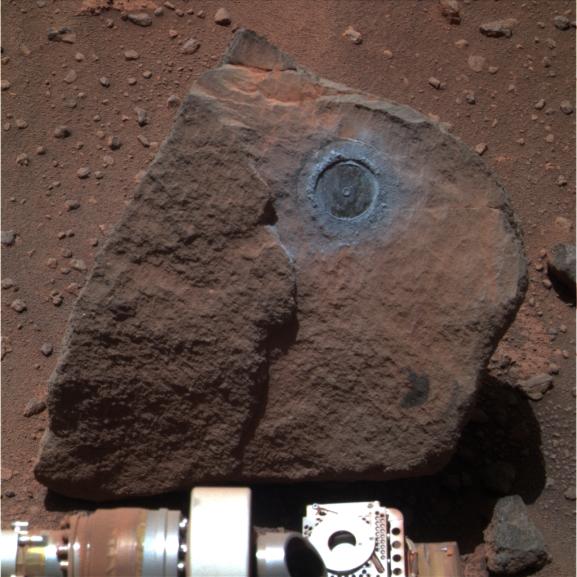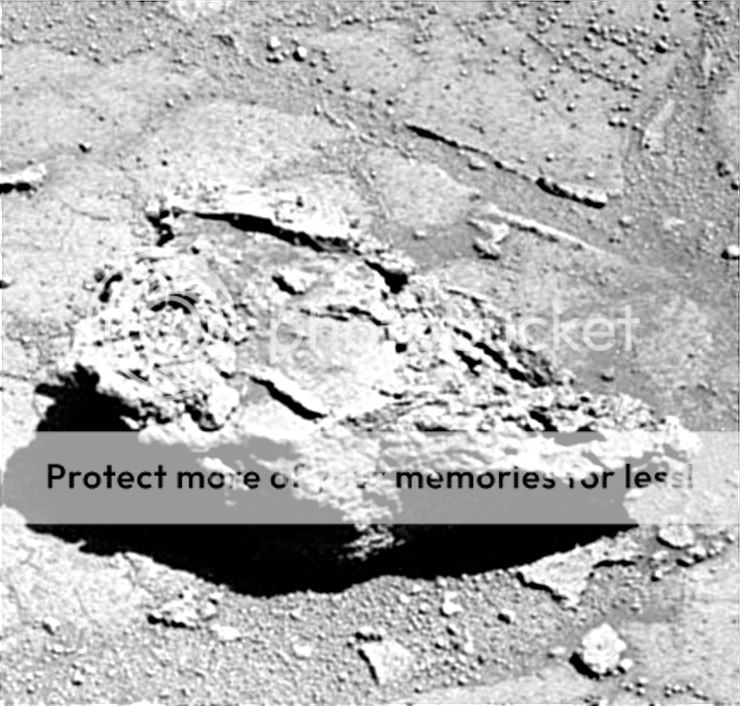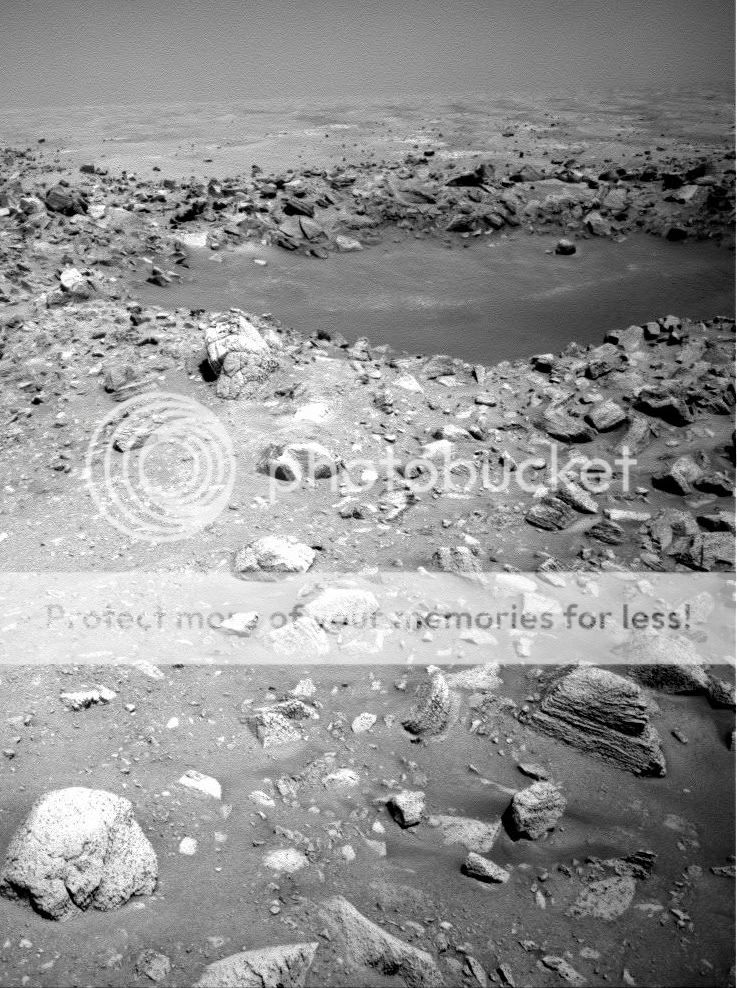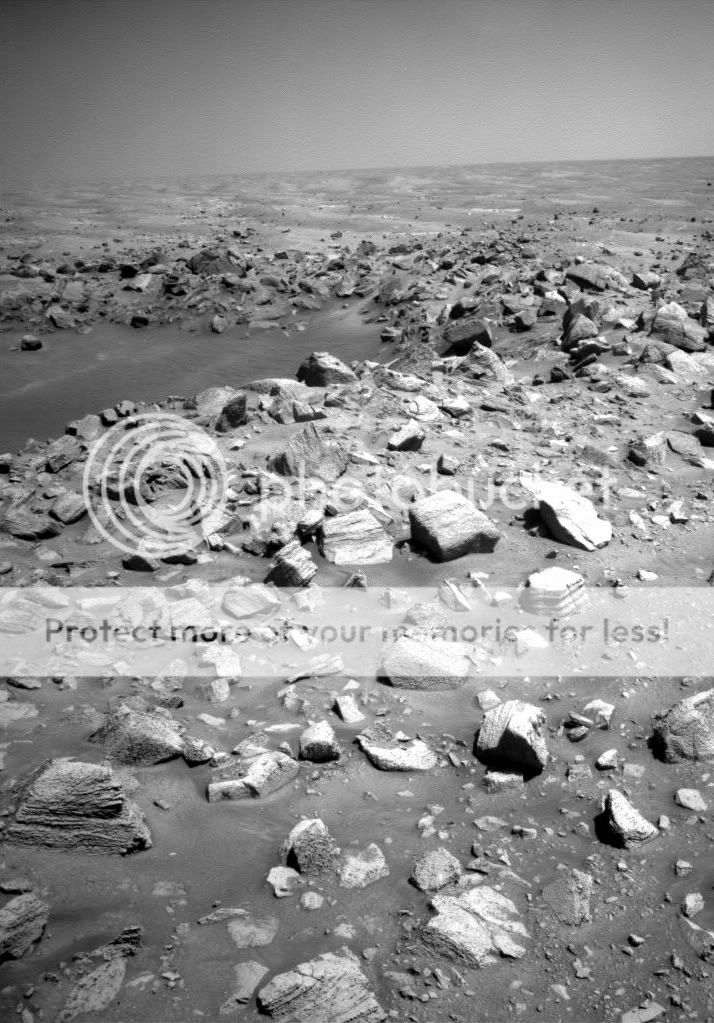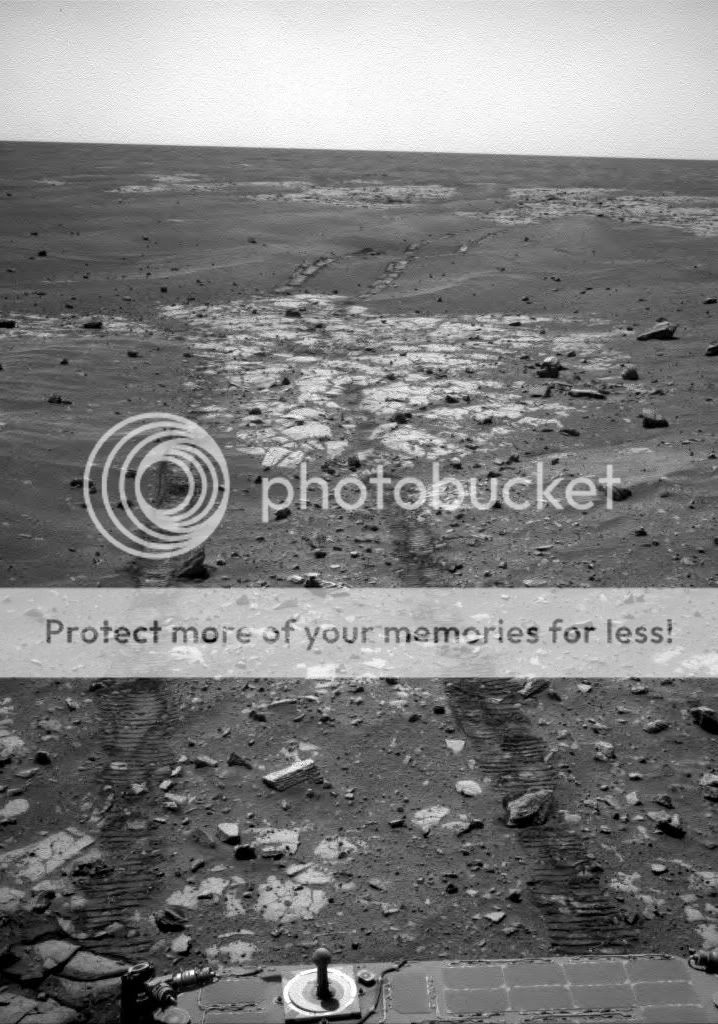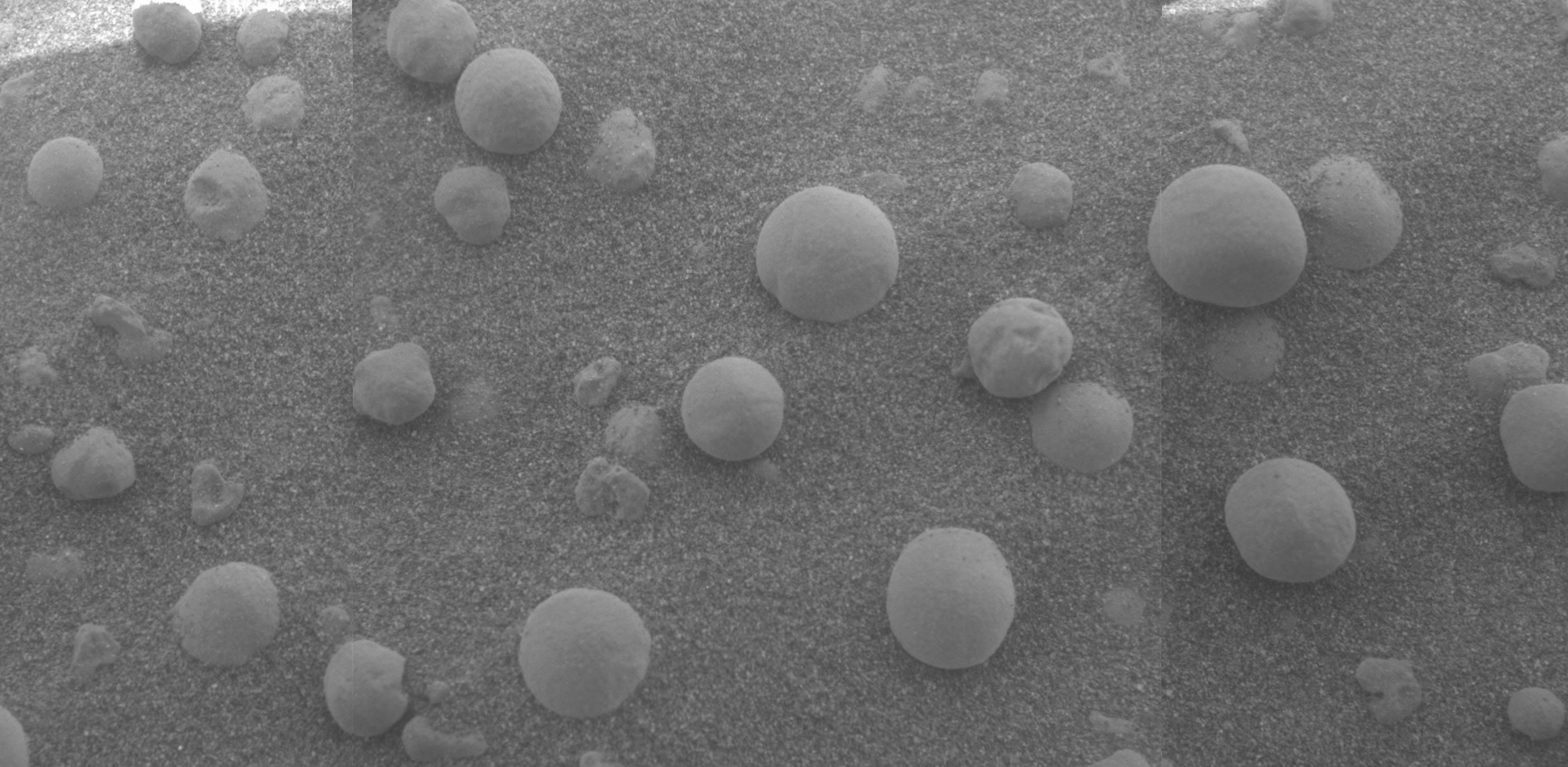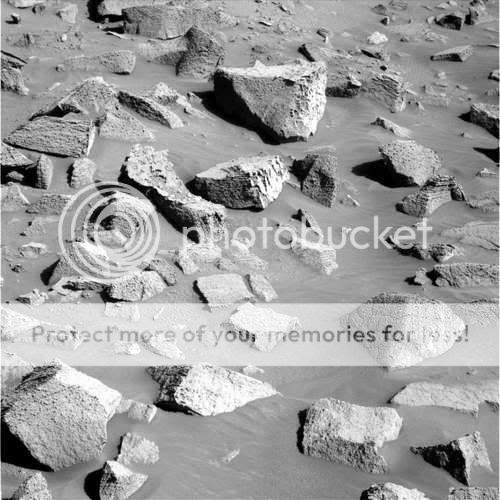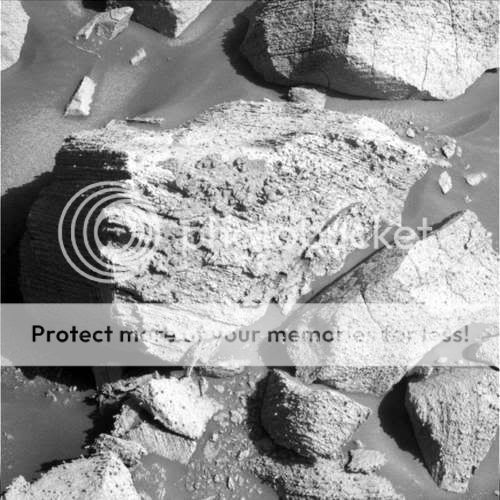M
MeteorWayne
Guest
Oppy is investigating another rock that may be a meteorite, called Marguette Island.
Here's an attempt to post an image:

If that doesn't work you can see it here, which also includes a link to a lrge image:
http://marsrovers.jpl.nasa.gov/gallery/ ... 1125a.html
Updates discussing the rock:
sols 2069-2075, November 18-24, 2009: 'Marquette' Study Continues
Opportunity has been investigating the rock known as "Marquette Island" over the last couple of weeks. This target is proving to be something unique that Opportunity has not encountered in more than 2000 Sols of exploring Mars.
The science team is theorizing this rock could be either be a type of meteorite that Opportunity has never seen before or it could be ejecta from deep within the Martian crust that might provide clues to Mars' geologic past. The rover completed Mössbauer (MB) spectrometer and Alpha-Particle-X-Ray Spectrometer (APXS) measurements on a rock target named "Peck Bay" last week. Peck Bay was also lightly brushed by the Rock Abrasion Tool (RAT), which removed a layer of dust on the rock to expose the material beneath.
To gain additional information on Marquette Island, Opportunity has repeated the same set of measurements on an adjacent target called "Islington Bay." The miniature thermal emission spectrometer (Mini-TES) elevation mirror shroud is being opened when appropriate with the expectation of eventual dust cleaning. No dust cleaning of the Mini-TES mirror has been noted yet.
As of Sol 2075 (Nov. 24, 2009), the solar array energy production was 371 watt-hours, with an atmospheric opacity (tau) of 0.512 and a dust factor of 0.520. Total odometry was 18,906.82 meters (11.75 miles).
--------------------------------------------------------------------------------
sols 2063-2068, November 12-17, 2009: 'Marquette' Study Begins
Opportunity has been investigating a rock called "Marquette Island."
The rover approached the rock on Sol 2063 (Nov. 12, 2009) and has been using the Moessbauer (MB) spectrometer and alpha particle X-ray spectrometer (APXS) to collect measurements on the rock to assist in determining the rock composition. Opportunity also has taken close-up images using the microscopic imager (MI) on Sol 2065 (Nov. 14, 2009).
The rock abrasion tool (RAT) on the arm will lightly brush the rock to reveal the surface beneath the layer of dust. After receiving the results of the RAT brush, the science team will decide whether to look even deeper into the rock by grinding a couple of millimeters (about a tenth of an inch) down into it and performing additional science observations.
There has also been extensive imaging of the surrounding rocks around Marquette. The elevation mirror shroud of the miniature thermal emission spectrometer (Mini-TES) is being opened when appropriate with the expectation of eventual dust cleaning. No dust cleaning of the Mini-TES mirror has been noted yet.
As of Sol 2068 (Nov. 17, 2009), Opportunity's solar-array energy production was 385 watt-hours, with an atmospheric opacity (tau) of 0.482 and a dust factor of 0.530. Total odometry was 18,906.82 meters (11.75 miles).
--------------------------------------------------------------------------------
sols 2057-2062, November 6-11, 2009: Approaching "Marquette Island"
Opportunity is still heading south before the turn east to head toward Endeavour Crater. The right front wheel is exhibiting elevated motor currents. So, the plan is to find a place to stop and rest the actuator while conducting some some contact science.
On Sol 2058 (Nov. 7, 2009), the rover began a 15-meter (49-foot) approach to a candidate rock target called "Marquette Island." On Sol 2061 (Nov. 10, 2009), Opportunity bumped about 4 meters (13 feet) to position Marquette Island within the work volume of the rover's robotic arm (instrument deployment device, or IDD). The rover continues to command the miniature thermal emission spectrometer (Mini-TES) elevation mirror open each sol in an attempt to clear some of the putative dust off the elevation mirror. To date, no improvement in the Mini-TES has been observed.
As of Sol 2062 (Nov. 11, 2009), Opportunity's solar-array energy production was 400 watt-hours, with an atmospheric opacity (tau) of 0.486 and a dust factor of 0.531. Total odometry was 18,905.90 meters (11.75 miles).
Here's an attempt to post an image:

If that doesn't work you can see it here, which also includes a link to a lrge image:
http://marsrovers.jpl.nasa.gov/gallery/ ... 1125a.html
Updates discussing the rock:
sols 2069-2075, November 18-24, 2009: 'Marquette' Study Continues
Opportunity has been investigating the rock known as "Marquette Island" over the last couple of weeks. This target is proving to be something unique that Opportunity has not encountered in more than 2000 Sols of exploring Mars.
The science team is theorizing this rock could be either be a type of meteorite that Opportunity has never seen before or it could be ejecta from deep within the Martian crust that might provide clues to Mars' geologic past. The rover completed Mössbauer (MB) spectrometer and Alpha-Particle-X-Ray Spectrometer (APXS) measurements on a rock target named "Peck Bay" last week. Peck Bay was also lightly brushed by the Rock Abrasion Tool (RAT), which removed a layer of dust on the rock to expose the material beneath.
To gain additional information on Marquette Island, Opportunity has repeated the same set of measurements on an adjacent target called "Islington Bay." The miniature thermal emission spectrometer (Mini-TES) elevation mirror shroud is being opened when appropriate with the expectation of eventual dust cleaning. No dust cleaning of the Mini-TES mirror has been noted yet.
As of Sol 2075 (Nov. 24, 2009), the solar array energy production was 371 watt-hours, with an atmospheric opacity (tau) of 0.512 and a dust factor of 0.520. Total odometry was 18,906.82 meters (11.75 miles).
--------------------------------------------------------------------------------
sols 2063-2068, November 12-17, 2009: 'Marquette' Study Begins
Opportunity has been investigating a rock called "Marquette Island."
The rover approached the rock on Sol 2063 (Nov. 12, 2009) and has been using the Moessbauer (MB) spectrometer and alpha particle X-ray spectrometer (APXS) to collect measurements on the rock to assist in determining the rock composition. Opportunity also has taken close-up images using the microscopic imager (MI) on Sol 2065 (Nov. 14, 2009).
The rock abrasion tool (RAT) on the arm will lightly brush the rock to reveal the surface beneath the layer of dust. After receiving the results of the RAT brush, the science team will decide whether to look even deeper into the rock by grinding a couple of millimeters (about a tenth of an inch) down into it and performing additional science observations.
There has also been extensive imaging of the surrounding rocks around Marquette. The elevation mirror shroud of the miniature thermal emission spectrometer (Mini-TES) is being opened when appropriate with the expectation of eventual dust cleaning. No dust cleaning of the Mini-TES mirror has been noted yet.
As of Sol 2068 (Nov. 17, 2009), Opportunity's solar-array energy production was 385 watt-hours, with an atmospheric opacity (tau) of 0.482 and a dust factor of 0.530. Total odometry was 18,906.82 meters (11.75 miles).
--------------------------------------------------------------------------------
sols 2057-2062, November 6-11, 2009: Approaching "Marquette Island"
Opportunity is still heading south before the turn east to head toward Endeavour Crater. The right front wheel is exhibiting elevated motor currents. So, the plan is to find a place to stop and rest the actuator while conducting some some contact science.
On Sol 2058 (Nov. 7, 2009), the rover began a 15-meter (49-foot) approach to a candidate rock target called "Marquette Island." On Sol 2061 (Nov. 10, 2009), Opportunity bumped about 4 meters (13 feet) to position Marquette Island within the work volume of the rover's robotic arm (instrument deployment device, or IDD). The rover continues to command the miniature thermal emission spectrometer (Mini-TES) elevation mirror open each sol in an attempt to clear some of the putative dust off the elevation mirror. To date, no improvement in the Mini-TES has been observed.
As of Sol 2062 (Nov. 11, 2009), Opportunity's solar-array energy production was 400 watt-hours, with an atmospheric opacity (tau) of 0.486 and a dust factor of 0.531. Total odometry was 18,905.90 meters (11.75 miles).


